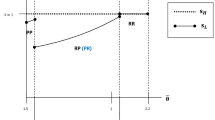Abstract.
Using a model according to Mussa and Rosen (1978) and Bonanno and Haworth (1998) we consider a sub-game perfect equilibrium of a two-stage game in a duopolistic industry in which the products of the firms are vertically differentiated. In the industry, there are a high quality firm and a low quality firm. In the first stage of the game, the firms choose their strategic variables, price or quantity. In the second stage, they determine the levels of their strategic variables. We will show that, under an assumption about distribution of consumers' preference, we obtain the result that is similar to Singh and Vives (1984)' proposition (their Proposition 3) in the case of substitutes with nonlinear demand functions. That is, in the first stage of the game, a quantity strategy dominates a price strategy for both firms.
Similar content being viewed by others
Author information
Authors and Affiliations
Additional information
Received: April 23, 1999; revised version: May 31, 2000
Rights and permissions
About this article
Cite this article
Tanaka, Y. Profitability of price and quantity strategies in a duopoly with vertical product differentiation. Econ Theory 17, 693–700 (2001). https://doi.org/10.1007/PL00004124
Issue Date:
DOI: https://doi.org/10.1007/PL00004124




